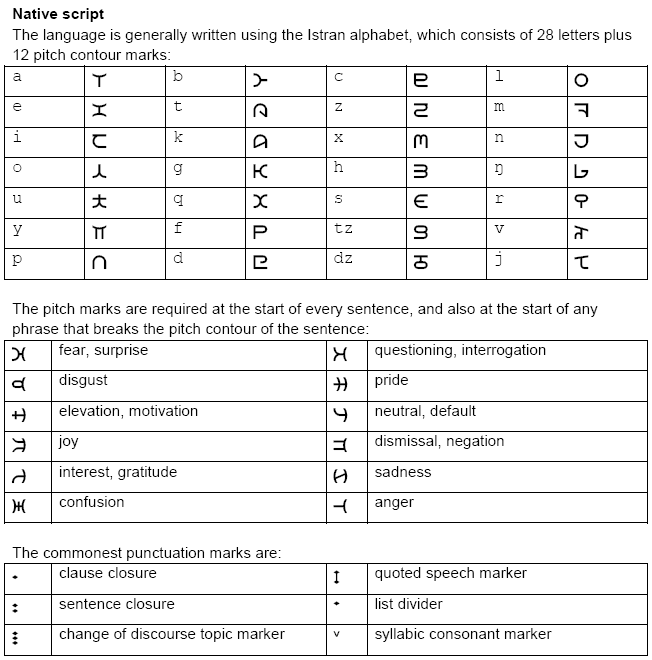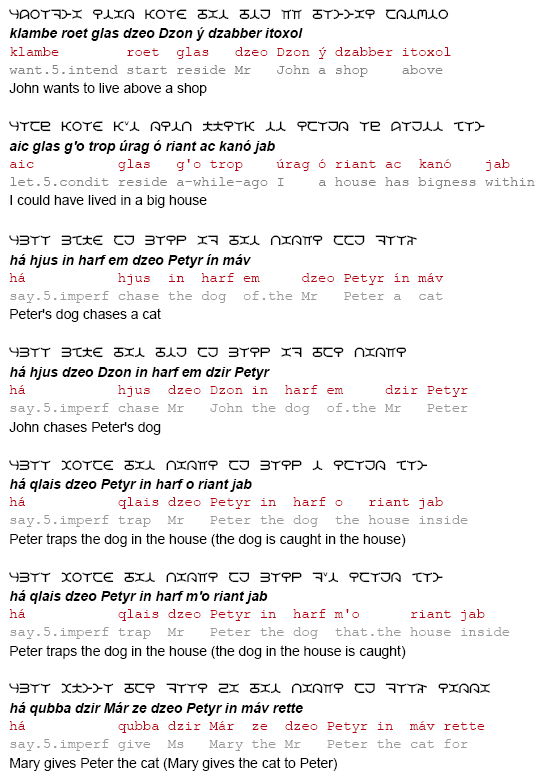Apart from when used as an imperative, or when a verb is being used as a yes/no response to a question, every O Yis verb will come with an auxiliary verb. Auxiliary verbs are conjugated; an auxiliary consists of a stem and a suffix. Conjugation is irregular.
The auxiliary carries out several tasks: it carries information about the grammatical mood of the clause, and also some aspectual details; it also carries information about the perceived status of the person being addressed. Furthermore, some auxiliaries carry tense information (past vs non-past) encoded lexically: different stems are used for each tenses.
The auxiliary suffix changes according to the state of the verb – in other words the intentionality and/or success of a given action. A verb will be in one of five states of completion:
- -ic, the possible or conditional state – an action may or may not happen
- -(mb)e, the intended state – definite plans have been made to undertake an action
- -a, the incomplete or imperfective state – the action has started but not yet completed
- -uk, the complete or perfective state – the action has finished (as far as possible) or stopped, but there's no indication of whether the result is satisfactory
- -(t)an, the satisfactory or telic state – the action has been completed and the outcome is satisfactory
Code: Select all
A table of auxiliary verb stems (part 1)
------------------------------------------------------------------------
spoken to: say believe know
past non-past past non-past past non-past
------------------------------------------------------------------------
children hil- hve- seŋ- sen- semb- seb-
close family hil- hve- seŋ- sen- semb- seb-
family friends hil- hve- seŋ- sen- semb- seb-
extended family hi- ha seŋ- sen- semb- seb-
friends hi- ha- seŋ- sen- semb- seb-
colleagues hi- ha- seŋ- sen- semb- seb-
acquaintances hi- ha- seŋva- seva- semb- seb-
strangers hit- hat- seŋva- seva- semb- seb-
authority figures hit- hat- seŋva- seva- svemb- svo-
social leaders hit- hat- seŋva- seva- svemb- svo-
A table of auxiliary verb stems (part 2)
------------------------------------------------------------
spoken to: like need let endure want
------------------------------------------------------------
children xik- ki- aq- vear- div-
close family xik- ki- a- vear- div-
family friends xi- ki- a- vear- div-
extended family xi- nek- a- vear- div-
friends xi- nek- a- vear- div-
colleagues xel- nek- a- vear- kla-
acquaintances xel- nek- a- vear- kla-
strangers xel- nek- a- vear- kla-
authority figures xel- njek- aq- vear- kla-
social leaders xel- njek- aq- vear- kla-
A table showing all combinations of auxiliary stems and suffixes
--------------------------------------------------------
| condit. intend imperf. perf. telic
--------------------------------------------------------
hil- | hilic hile hila hiluk hiltan
hi- | híc himbe hia hiuk hitan
hit- | hitic hite hita hituk híttan
|
hve- | hveic hvembe hvea hveuk hvetan
ha- | haic hambe há hauk hatan
hat- | hatic hate hata hatuk háttan
|
seŋ- | seŋic seŋe seŋa seŋuk seŋan
seŋva- | seŋvaic seŋvambe seŋvá seŋvauk seŋván
|
sen- | senic sene sena senuk senan
seva- | sevaic sevambe sevá sevauk seván
|
semb- | sembic sembe semba sembuk semban
svemb- | svembic svembe svemba svembuk svemban
|
seb- | sebic sebe seba sebuk seban
svo- | svoic svombe svoa svouk svotan
|
xik- | xikic xike xika xikuk xikan
xi- | xíc ximbe xia xiuk xitan
xel- | xelic xelbe xela xeluk xeltan
|
ki- | kík kimbe kia kiuk kitan
nek- | nekic neke neka nekuk nekan
njek- | njekic njeke njeka njekuk njekan
|
aq- | aqic aqe aqa aquk aqan
a- | aic ambe á auk atan
|
vear- | vearic veare veara vearuk veartan
|
div- | divic dive diva divuk divan
kla- | klaic klambe klá klauk klatan






